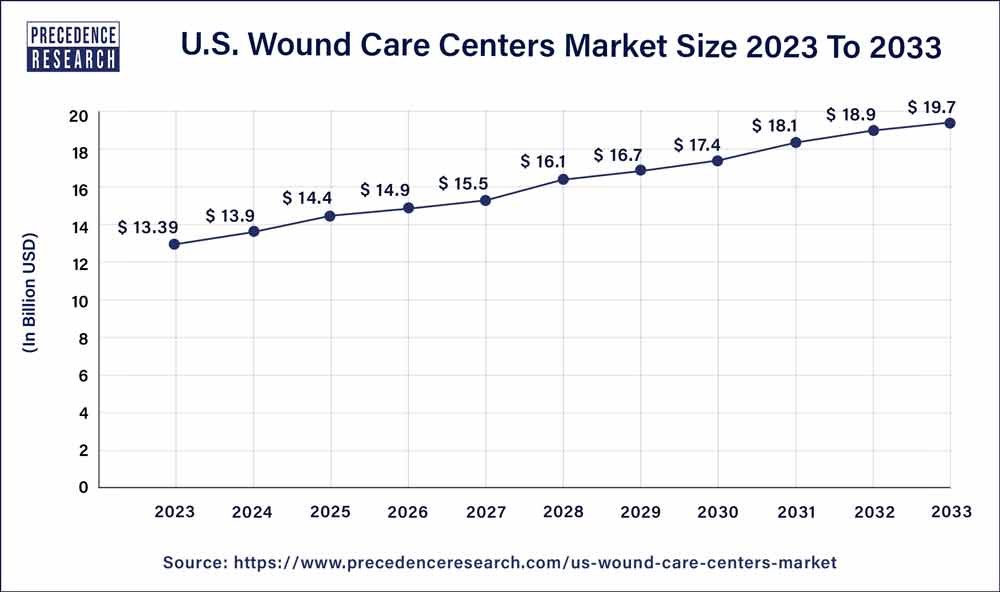Introduction:
The U.S. Wound Care Centers Market is experiencing a transformative phase driven by a combination of factors, including advancements in medical technology, an aging population, and the increasing prevalence of chronic wounds. Wound care centers play a pivotal role in the healthcare ecosystem by providing specialized treatments and therapies for various types of wounds. As the demand for effective wound management solutions rises, the U.S. Wound Care Centers Market has witnessed substantial growth, becoming a critical component in the overall healthcare landscape.
Get a Sample: https://www.precedenceresearch.com/sample/3727
Growth Factors:
Several factors contribute to the growth of the U.S. Wound Care Centers Market. The aging population, with its associated increase in chronic conditions such as diabetes and vascular diseases, has led to a higher incidence of chronic wounds. This demographic trend has created a substantial demand for advanced wound care solutions and specialized treatment centers. Additionally, technological advancements in wound care products and therapies, including the development of innovative dressings, bioactive materials, and advanced wound care devices, further drive the market’s growth. The increasing emphasis on patient-centric care and the adoption of evidence-based practices also contribute to the expansion of wound care centers.
U.S. Wound Care Centers Market Scope
| Report Coverage |
Details |
| Growth Rate from 2024 to 2033 |
CAGR of 5.06% |
| U.S. Market Size in 2023 |
USD 1,468.72 Million |
| U.S. Market Size by 2033 |
USD 2,390.89 Million |
| Base Year |
2023 |
| Forecast Period |
2024 to 2033 |
| Segments Covered |
By Type and By Procedure |
U.S. Wound Care Centers Market Dynamics
Drivers:
Key drivers propelling the U.S. Wound Care Centers Market include the rising awareness about the importance of timely and effective wound management, both among healthcare professionals and the general public. With an increasing focus on preventing complications and improving patient outcomes, healthcare providers are increasingly referring patients to specialized wound care centers. Furthermore, the integration of digital health technologies, such as telemedicine and remote monitoring, has facilitated better communication between patients and healthcare providers, enhancing the overall efficiency and effectiveness of wound care services.
Restraint:
Despite the positive growth trajectory, the U.S. Wound Care Centers Market faces certain challenges. Reimbursement issues and the complex regulatory landscape can pose hurdles for healthcare providers and impact the financial sustainability of wound care centers. Additionally, the shortage of skilled wound care professionals may limit the capacity of these centers to meet the growing demand for specialized services. Addressing these challenges will be crucial for sustaining the momentum of growth in the U.S. Wound Care Centers Market.
Opportunity:
The U.S. Wound Care Centers Market presents significant opportunities for innovation and collaboration within the healthcare industry. Continued research and development efforts to create advanced wound care solutions, including personalized treatments and regenerative therapies, can open new avenues for market growth. Collaboration between wound care centers, healthcare providers, and technology companies to enhance data interoperability and streamline patient care pathways can contribute to improved outcomes. Moreover, expanding the reach of wound care services to underserved areas and populations represents an untapped opportunity for market expansion.
Region Snapshot
The U.S. Wound Care Centers Market is dynamic, with regional variations influenced by factors such as population density, healthcare infrastructure, and demographic trends. Urban centers with higher concentrations of healthcare facilities often see greater access to specialized wound care services. However, efforts to address healthcare disparities and promote equitable access to wound care across regions are underway. The market’s evolution is closely tied to regional healthcare policies, reimbursement structures, and initiatives aimed at improving overall healthcare quality and outcomes. As the U.S. healthcare system continues to evolve, the role and impact of wound care centers are expected to remain pivotal across diverse regions.
Read Also: Electric Diaphragm Pump Market Size to Surpass USD 4.30 Bn by 2033

